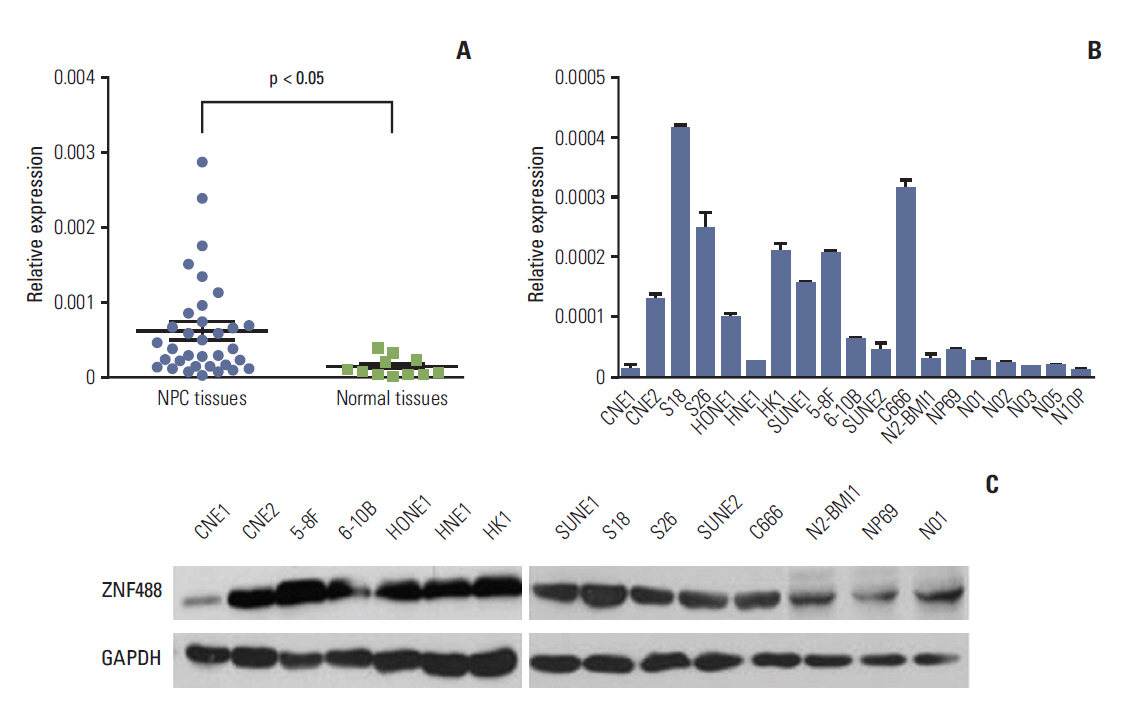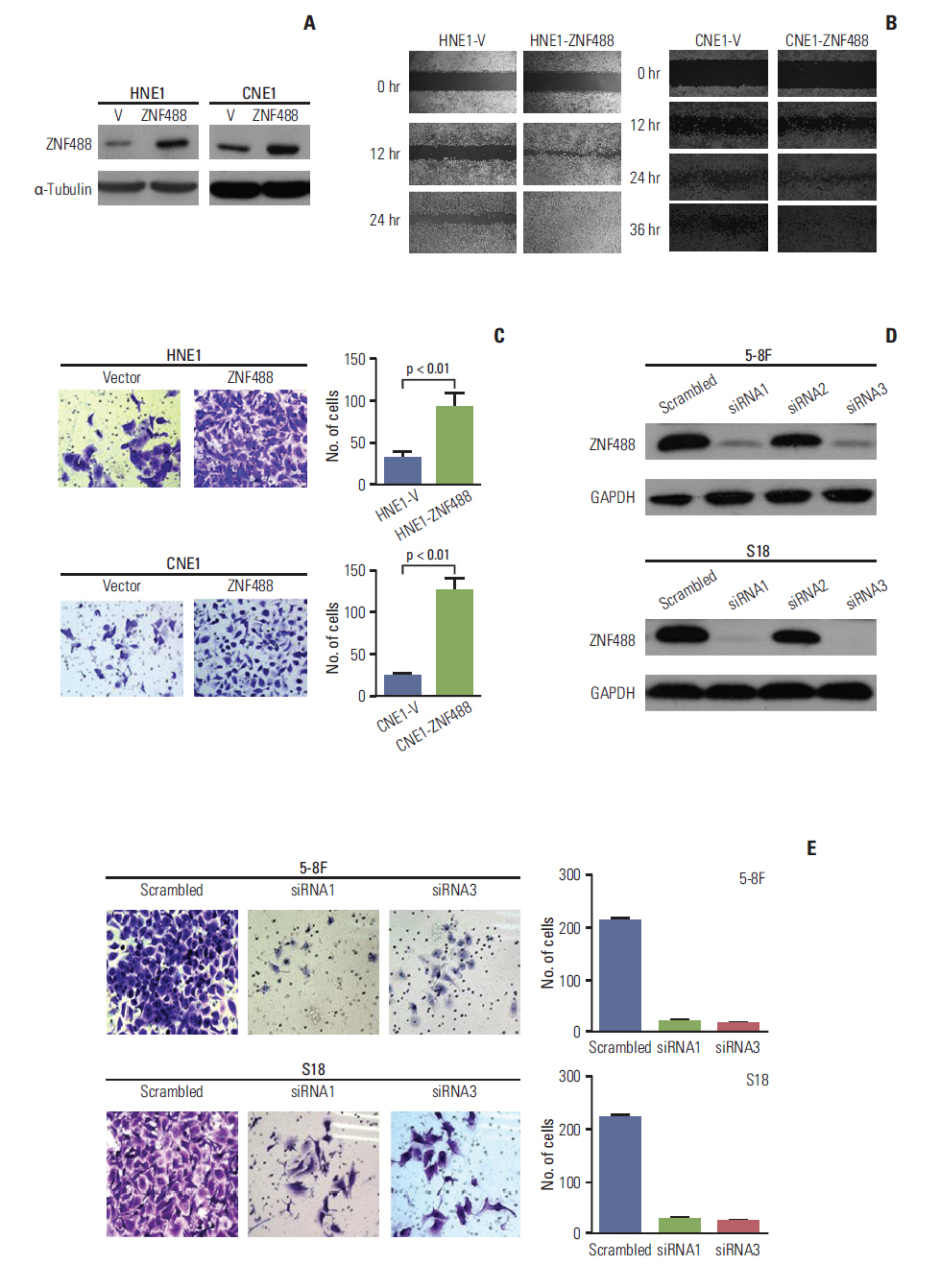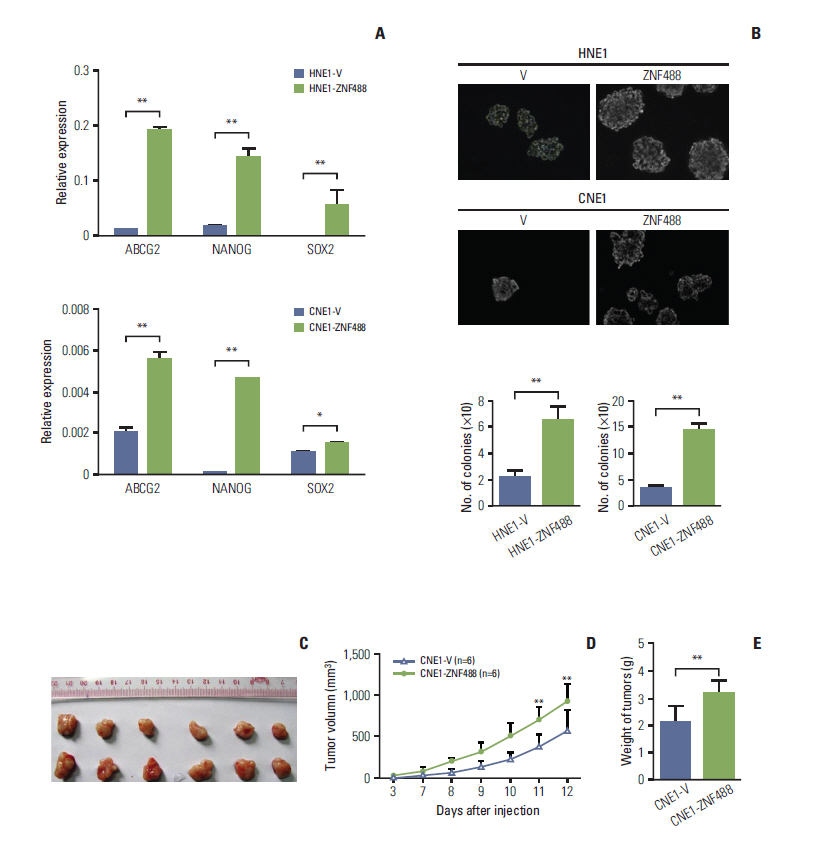Cancer Res Treat.
2016 Jan;48(1):334-344. 10.4143/crt.2014.311.
ZNF488 Enhances the Invasion and Tumorigenesis in Nasopharyngeal Carcinoma Via the Wnt Signaling Pathway Involving Epithelial Mesenchymal Transition
- Affiliations
-
- 1Jiangsu Cancer Hospital, Nanjing Medical University, Jiangsu Key Laboratory of Molecular and Translational Cancer Research, Nanjing, China. hexia200302@tom.com
- 2State Key Laboratory of Oncology in South China, Sun Yat-Sen University Cancer Center, Guangzhou, China. zengmsh@mail.sysu.edu.cn
- 3Sun Yat-sen Memorial Hospital, Sun Yat-Sen University, Guangzhou, China.
- KMID: 2152292
- DOI: http://doi.org/10.4143/crt.2014.311
Abstract
- PURPOSE
The purpose of this study was to investigate the function of Zinc finger protein 488 (ZNF488) in nasopharyngeal carcinoma (NPC).
MATERIALS AND METHODS
The endogenous expression of ZNF488 in NPC tissues, normal nasopharyngeal epithelium tissues and NPC cell lines were detected by quantitative reverse transcription polymerase chain reaction. ZNF488 over-expressing and knock-down NPC cell line models were established through retroviral vector pMSCV mediated over-expression and small interfering RNA (siRNA) mediated knock-down. The invasion and migration capacities were evaluated by wound healing and transwell invasion assays in ZNF488 over-expressing and control cell lines. Soft-agar colony formation and a xenograft experiment were performed to study tumorigenic ability in vitro and in vivo. Immunofluorescence and western blotting analysis were used to examine protein changes followed by ZNF488 over-expression. Microarray analysis was performed to explore gene expression profilings, while luciferase reporter assay to evaluate the transcriptive activity of Tcf/Lef.
RESULTS
ZNF488 was over-expressed in NPC tissues compared with normal tissues, especially higher in 5-8F and S18, which are well-established high metastatic NPC clones. Functional studies indicate that over-expression of ZNF488 provokes invasion, whereas knock-down of ZNF488 alleviates invasive capability. Moreover, over-expression of ZNF488 promotes NPC tumor growth both in vitro and in vivo. Our data further show that over-expression of ZNF488 induces epithelial mesenchymal transition (EMT) by activating the WNT/beta-catenin signaling pathway.
CONCLUSION
Our data strongly suggest that ZNF488 acts as an oncogene, promoting invasion and tumorigenesis by activating the Wnt/beta-catenin pathway to induce EMT in NPC.
Keyword
MeSH Terms
-
Blotting, Western
Carcinogenesis*
Cell Line
Clone Cells
Epithelial-Mesenchymal Transition*
Epithelium
Fluorescent Antibody Technique
Gene Expression Profiling
Heterografts
Luciferases
Microarray Analysis
Oncogenes
Polymerase Chain Reaction
Reverse Transcription
RNA, Small Interfering
Wnt Signaling Pathway*
Wound Healing
Zidovudine
Zinc Fingers
Luciferases
RNA, Small Interfering
Zidovudine
Figure
Reference
-
References
1. Lee AW, Ng WT, Chan YH, Sze H, Chan C, Lam TH. The battle against nasopharyngeal cancer. Radiother Oncol. 2012; 104:272–8.
Article2. Zhang L, Zhao C, Ghimire B, Hong MH, Liu Q, Zhang Y, et al. The role of concurrent chemoradiotherapy in the treatment of locoregionally advanced nasopharyngeal carcinoma among endemic population: a meta-analysis of the phase III randomized trials. BMC Cancer. 2010; 10:558.
Article3. Xu ZJ, Zheng RS, Zhang SW, Zou XN, Chen WQ. Nasopharyngeal carcinoma incidence and mortality in China in 2009. Chin J Cancer. 2013; 32:453–60.
Article4. Razak AR, Siu LL, Liu FF, Ito E, O'Sullivan B, Chan K. Nasopharyngeal carcinoma: the next challenges. Eur J Cancer. 2010; 46:1967–78.
Article5. Lupo A, Cesaro E, Montano G, Zurlo D, Izzo P, Costanzo P. KRAB-Zinc finger proteins: a repressor family displaying multiple biological functions. Curr Genomics. 2013; 14:268–78.
Article6. Lai KP, Chen J, He M, Ching AK, Lau C, Lai PB, et al. Overexpression of ZFX confers self-renewal and chemoresistance properties in hepatocellular carcinoma. Int J Cancer. 2014; 135:1790–9.
Article7. Yang G, Ma F, Zhong M, Fang L, Peng Y, Xin X, et al. ZNF703 acts as an oncogene that promotes progression in gastric cancer. Oncol Rep. 2014; 31:1877–82.
Article8. Vendrell JA, Thollet A, Nguyen NT, Ghayad SE, Vinot S, Bieche I, et al. ZNF217 is a marker of poor prognosis in breast cancer that drives epithelial-mesenchymal transition and invasion. Cancer Res. 2012; 72:3593–606.
Article9. Wang SZ, Dulin J, Wu H, Hurlock E, Lee SE, Jansson K, et al. An oligodendrocyte-specific zinc-finger transcription regulator cooperates with Olig2 to promote oligodendrocyte differentiation. Development. 2006; 133:3389–98.
Article10. Soundarapandian MM, Selvaraj V, Lo UG, Golub MS, Feldman DH, Pleasure DE, et al. Zfp488 promotes oligodendrocyte differentiation of neural progenitor cells in adult mice after demyelination. Sci Rep. 2011; 1:2.
Article11. Song LB, Zeng MS, Liao WT, Zhang L, Mo HY, Liu WL, et al. Bmi-1 is a novel molecular marker of nasopharyngeal carcinoma progression and immortalizes primary human nasopharyngeal epithelial cells. Cancer Res. 2006; 66:6225–32.
Article12. Mani SA, Guo W, Liao MJ, Eaton EN, Ayyanan A, Zhou AY, et al. The epithelial-mesenchymal transition generates cells with properties of stem cells. Cell. 2008; 133:704–15.
Article13. Song LB, Li J, Liao WT, Feng Y, Yu CP, Hu LJ, et al. The polycomb group protein Bmi-1 represses the tumor suppressor PTEN and induces epithelial-mesenchymal transition in human nasopharyngeal epithelial cells. J Clin Invest. 2009; 119:3626–36.
Article14. Anastas JN, Moon RT. WNT signalling pathways as therapeutic targets in cancer. Nat Rev Cancer. 2013; 13:11–26.
Article15. Yu M, Ting DT, Stott SL, Wittner BS, Ozsolak F, Paul S, et al. RNA sequencing of pancreatic circulating tumour cells implicates WNT signalling in metastasis. Nature. 2012; 487:510–3.
Article16. Deng CC, Liang Y, Wu MS, Feng FT, Hu WR, Chen LZ, et al. Nigericin selectively targets cancer stem cells in nasopharyngeal carcinoma. Int J Biochem Cell Biol. 2013; 45:1997–2006.
Article17. Liu X, Lv XB, Wang XP, Xu S, Hu K, et al. MiR-138 suppressed nasopharyngeal carcinoma growth and tumorigenesis by targeting the CCND1 oncogene. Cell Cycle. 2012; 11:2495–506.
Article18. Wendt MK, Schiemann BJ, Parvani JG, Lee YH, Kang Y, Schiemann WP. TGF-beta stimulates Pyk2 expression as part of an epithelial-mesenchymal transition program required for metastatic outgrowth of breast cancer. Oncogene. 2013; 32:2005–15.19. Nicolini A, Ferrari P, Fini M, Borsari V, Fallahi P, Antonelli A, et al. Stem cells: their role in breast cancer development and resistance to treatment. Curr Pharm Biotechnol. 2011; 12:196.
Article20. Wang Y, Xu Z, Jiang J, Xu C, Kang J, Xiao L, et al. Endogenous miRNA sponge lincRNA-RoR regulates Oct4, Nanog, and Sox2 in human embryonic stem cell self-renewal. Dev Cell. 2013; 25:69–80.
Article21. Yanamoto S, Yamada S, Takahashi H, Naruse T, Matsushita Y, Ikeda H, et al. Expression of the cancer stem cell markers CD44v6 and ABCG2 in tongue cancer: effect of neoadjuvant chemotherapy on local recurrence. Int J Oncol. 2014; 44:1153.
Article22. Tsai HL, Deng WP, Lai WF, Chiu WT, Yang CB, Tsai YH, et al. Wnts enhance neurotrophin-induced neuronal differentiation in adult bone-marrow-derived mesenchymal stem cells via canonical and noncanonical signaling pathways. PLoS One. 2014; 9:e104937.
Article23. Aguirre A, Rubio ME, Gallo V. Notch and EGFR pathway interaction regulates neural stem cell number and self-renewal. Nature. 2010; 467:323–7.
Article24. Sirko S, Behrendt G, Johansson PA, Tripathi P, Costa M, Bek S, et al. Reactive glia in the injured brain acquire stem cell properties in response to sonic hedgehog. [corrected]. Cell Stem Cell. 2013; 12:426–39.25. Micalizzi DS, Farabaugh SM, Ford HL. Epithelial-mesenchymal transition in cancer: parallels between normal development and tumor progression. J Mammary Gland Biol Neoplasia. 2010; 15:117–34.
Article
- Full Text Links
- Actions
-
Cited
- CITED
-
- Close
- Share
- Similar articles
-
- Understanding of Cementum Formation by the Wnt/β-Catenin Signaling
- Targeting epithelial-mesenchymal transition pathway in hepatocellular carcinoma
- The Long Noncoding RNA NEAT1 Targets miR-34a-5p and Drives Nasopharyngeal Carcinoma Progression via Wnt/β-Catenin Signaling
- Wnt signaling in liver regeneration, disease, and cancer
- The Potential Role of Elk-3/Egr-1 Signaling Pathway in the Epithelial-Mesenchymal Transition during Liver Fibrosis





